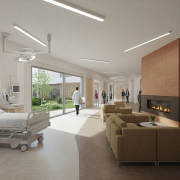Healthcare Architecture: Designing for Healing
Beyond only building practical spaces, healthcare architecture aims to design surroundings that encourage well-being and enable patient recovery as well as the vital job of medical personnel. Such design calls for rigorous evaluation of particular demands and issues inside hospitals, clinics, and other healthcare facilities.
Design Based on Patients
 Starting the healing process with the patient experience, reduced noise levels, lots of natural light, access to nature or soothing views, and design features all greatly affect patient comfort and help to lower anxiety. Less stressful experiences result from thoughtful wayfinding, clear signage, and cozy waiting rooms. Private rooms with separate controls over temperature and lighting improve patient autonomy and rest—qualities essential for rehabilitation.
Starting the healing process with the patient experience, reduced noise levels, lots of natural light, access to nature or soothing views, and design features all greatly affect patient comfort and help to lower anxiety. Less stressful experiences result from thoughtful wayfinding, clear signage, and cozy waiting rooms. Private rooms with separate controls over temperature and lighting improve patient autonomy and rest—qualities essential for rehabilitation.
Efficiency and Functionality
Healthcare facilities have to be extremely useful and efficient for staff members, going beyond staff comfort. Layouts must maximize workflow to let doctors, nurses, and support personnel navigate them easily. Along with well-designed areas for cooperation and consulting, the strategic arrangement of tools and supplies can help lower medical errors and increase efficiency. Priority is infection control; hence, careful material choice and design that promotes simple cleaning and reduces pathogen spread are necessary.
Flexibility and Future-Proofing
Needs in healthcare are changing all the time. Designing flexible rooms is therefore absolutely vital. Flexible room layouts, modular designs, and the integration of technological infrastructure help buildings adapt to medical practices and future needs. Using environmentally friendly materials and energy-efficient designs helps one to consider sustainability and promotes long-term well-being by lowering running costs. Good healthcare design ultimately combines compassion with pragmatism to create environments that facilitate healing and care.

